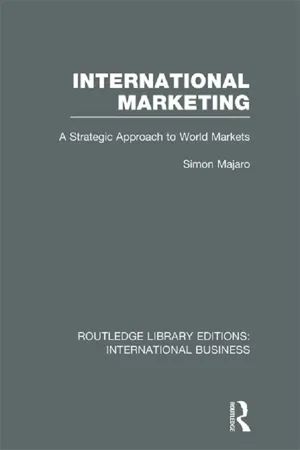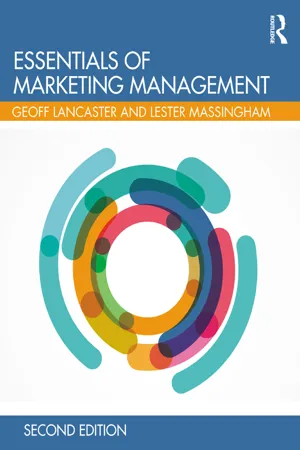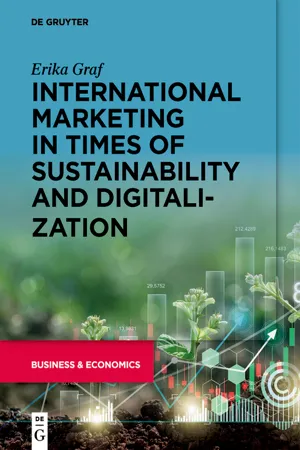Marketing
Distribution Decisions
Distribution decisions refer to the strategic choices made by a company regarding how its products or services will be delivered to customers. This includes decisions about the channels of distribution, such as direct sales, wholesalers, retailers, or e-commerce platforms, as well as considerations about inventory management, logistics, and transportation. Effective distribution decisions are crucial for reaching target markets and ensuring customer satisfaction.
Written by Perlego with AI-assistance
Related key terms
1 of 5
12 Key excerpts on "Distribution Decisions"
- eBook - PDF
- William Pride, O. C. Ferrell(Authors)
- 2019(Publication Date)
- Cengage Learning EMEA(Publisher)
PART 6: Distribution Decisions 396 The distribution component of the marketing mix focuses on the decisions and activities involved in making products available to customers when and where they want to purchase them. Fanatics has become an expert at making trendy products available when they are wanted—as soon as a team wins big—through a variety of marketing channels. Choosing which channels of distribution to use to reach customers in a timely manner is a major decision in the development of marketing strategies. In this chapter, we focus on marketing channels and supply chain management. First, we explore the concept of the supply chain and its various activities. Second, we elaborate on marketing channels and the need for intermediaries and the primary functions they perform. Next, we outline the types and characteristics of marketing channels, discuss how they are selected, and explore how marketers determine the appropriate intensity of market coverage for a product. We then examine the strategic channel issues of leadership, cooperation, and conflict. We also look at the role of logistics within the supply chain, including its objectives and basic functions. Finally, we look at several legal issues that affect channel management. 14-1 FOUNDATIONS OF THE SUPPLY CHAIN An important function of distribution is to create an effective supply chain, which includes all the organizations and activities involved with the flow and transformation of products from raw materials through to the end customer. It may help to think of the firms involved in a total distribution system as existing along a conceptual line, the combined impact of which results in an effective supply chain. Firms that are “upstream” in the supply chain (e.g., suppliers) and “downstream” (e.g., wholesalers and retailers) work together to serve customers and generate competitive advantage. - eBook - PDF
Marketing Management N5 SB
TVET FIRST
- J Wiehan I Govender(Author)
- 2018(Publication Date)
- Macmillan(Publisher)
The influence of Distribution Decisions Distribution involves making important decisions about who the product or service’s target market is, which intermediaries to use, and how to transport products. Figure 2.2 shows the marketing factors that influence Distribution Decisions. Marketing factors that influence Distribution Decisions Consumer needs Pricing Product Sales Promotion The type of product often guides distribution options Some products need special handling and storage : Perishables (vegetables, flowers, some medicines) need quick shipping and short distribution channels; frozen foods need temperature control; hazardous products (such as fireworks) need special packaging and handling Businesses need to make decisions about the distribution strategy for new products Distribution costs directly affect the price of a product (if the ingredients of a restaurant meal are imported, the meal is more expensive) Longer distribution channels with more members cost more, as each member makes a profit and adds value Businesses must consider distribution costs when pricing their products and services Well-planned distribution reduces product prices Products must be available at the right place and in the right quantity for effective sales Inefficient distribution can lead to an oversupply or undersupply of goods, late deliveries, incorrect deliveries, or poor customer satisfaction, which in turn affect sales and profits A business’s promotional strategy depends on its intermediaries Marketers can use sales incentives to encourage intermediaries such as wholesalers and retailers to ‘push’ the product down the channel towards customers Promotion can also be aimed at ‘ pulling ’ the customer towards the product, through advertising and promotional deals The needs and wants of consumers will impact on distribution design An industrial user may prefer to deal directly with a manufacturer requiring a short distribution channel A manufacturer of convenience goods that has a wide consumer market can for example use national retailers to reach consumers Figure 2.2: Marketing factors that influence Distribution Decisions - eBook - ePub
International Marketing (RLE International Business)
A Strategic Approach to World Markets
- Simon Majaro(Author)
- 2013(Publication Date)
- Routledge(Publisher)
Chapter 8Distribution Decisions in International Marketing
Distribution Decisions are pretty difficult in domestic marketing; they are even more complicated in international marketing. The problem of selecting the right channels is simply multiplied by as many countries as one wishes to serve. Yet it is essential for companies which market their products internationally to be able to find their way through the maze of channels that are available or can be developed in each market.The variations that exist in institutional availability are very extensive indeed and no one person can ever hope to become aware of the details of the channel options in every country. Furthermore, environmental and legal constaints play an enormous role in the choices that can be made and the distribution strategies that can be explored.It is important to remember that the best product in the world may prove a commercial disaster if the channels of distribution selected are incapable or unwilling to provide the ‘utility of place’ and the ‘utility of time’ which the local consumer expects. The expectation of the consumer is ultimately the criterion of effectiveness and therefore failure to satisfy the consumer means a poor marketing effort.This chapter deals with two interrelated aspects of the distribution process: Channels of distribution in world markets. Physical distribution (logistics) for the international manufacturer.Channels of Distribution in World Markets
An international company can have a number of bases from which channel decisions originate. A manufacturing orientated company would have a number of plants located around the world and Distribution Decisions will probably stem from logistics rather than marketing considerations. On the other hand, a marketing orientated company will look at the problem differently: it will identify the best marketing opportunities, determine distribution patterns and then seek to recommend locations for manufacturing facilities which could best serve the marketing objectives. - eBook - PDF
Consumer Behaviour NQF4 SB
TVET FIRST
- Sparrow Consulting(Author)
- 2013(Publication Date)
- Macmillan(Publisher)
In this sense, distribution is a very important part of the marketing process, because, if the products aren’t in the shops, the consumers can’t buy them. In this module, we are going to discuss a few aspects related to distribution, such as distribution strategies, distribution channels, and cost factors. You will also be introduced to the role played by the middleman in the distribution process. 91 Module 10: Demonstrate an understanding of the nature and extent of distribution Unit 10 .1: Define the distribution concepts to demonstrate understanding Have you ever desperately needed to buy something, only to find that all the shelves in the shop are empty? Have you ever wondered how all the products get to the shops on time? Can you imagine what a big job it is to get all the millions of products from the producers to the shops where they are sold? This is what distribution is all about. What is distribution? The word ‘distribution’ is derived from the word ‘distribute’, which, as you know, means to spread out or divide out something. In terms of the wholesale and retail industry, we can say that the term ‘distribution’ refers to the path that products travel from where they are produced or manufactured to their final destination where they are needed by the consumers; in other words, distribution is the process of getting the products from the producers to the retailers, where consumers buy them. Effective marketing involves knowing what the consumers want, and then seeing that it gets to them through effective distribution. As you can imagine, products are needed at, and are distributed to, a variety of different places, and it is because of this that distribution is such an important aspect of the wholesale and retail industry. Distribution takes place every second of the day and night, right throughout the world. For example, how does your shop get fresh bread every day? Distribution is an important aspect of everyday living and consuming. - eBook - ePub
- Geoffrey Lancaster, Lester Massingham(Authors)
- 2017(Publication Date)
- Routledge(Publisher)
• Some organizations have limited discretion over marketing channel choice owing to economic conditions and legal restrictions. In certain of the Eastern European and Baltic countries, such as Estonia, Latvia and Uzbekistan, there is still restricted choice in terms of the range and scope of retail outlets for marketers.Any channel decision will have long-term implications for the company: for example, price will be affected depending on the number of levels between the manufacturer and the end user. A decision to change channels is likely be long-term, so it is important that existing channel structures are constantly reviewed to exploit opportunities.Strategic channel choices
An important consideration when formulating channel policy is the degree of market exposure sought by the company. Choices available include:• Intensive distribution: where products are placed in as many outlets as possible. This is most common when customers purchase goods frequently: for example, household goods such as detergents or toothpaste. Wide exposure gives customers many opportunities to buy and the image of the outlet is not important. The aim is to achieve maximum coverage.• Selective distribution: where products are placed in a more limited number of outlets in defined geographic areas. Instead of widespread exposure, selective distribution seeks to show products – such as high-end ‘designer’ clothes – in the most promising or profitable outlets.• Exclusive distribution: where products are placed in one outlet in a specific area. This brings about a stronger partnership between seller and re-seller and results in strong bonds of loyalty. Part of the agreement usually requires the dealer not to carry competing lines, and the result is a more aggressive selling effort by the distributor of the company’s products: an example might be an exclusive franchise to sell a vehicle brand in a specific geographical area in return for which the franchisee agrees to supply an appropriate after-sales service.We can see that there are several key decisions to make when determining the company’s distribution system. Its importance is underlined by the fact that the choice of distribution channel has an effect on all elements of the marketing mix and these are long term. - eBook - ePub
- Paul Reynolds, Geoff Lancaste(Authors)
- 2013(Publication Date)
- Routledge(Publisher)
9Channels ofdistribution9.1 IntroductionThis chapter investigates the routes marketing companies take when attempting to ensure that their goods and services reach the intended market or market segments.The term ‘distribution system’ refers to that complex of agents, wholesalers and retailers through which manufacturers move products to their intended markets. Marketing channels are usually made up of independent firms who are in business to make a profit. These are known as marketing intermediaries or middlemen. Distribution outlets can include combinations of owned and independent outlets, or arrangements like franchising.DefinitionThe term ‘distribution system’ refers to that complex of agents, wholesalers and retailers through which manufacturers move products to their intended markets.9.2 Direct versus indirect systemsIn designing a distribution system, a manufacturer must make a policy choice between selling directly to customers and employing salespeople, and using intermediaries – i.e. selling through agents, wholesalers and retailers. Initially, the decision is usually based on cost factors. Distribution costs are largely a function of:- the number of potential customers in the market
- how concentrated or dispersed they are
- how much each will buy in a given period
- costs associated with the practical side of the distributive operation (e.g. transport, warehousing and stockholding, all of which are dealt with in detail in Chapter 10 ).
Industrial goods manufacturers tend to use direct selling and often deliver direct to the user/customer, although in some cases wholesalers or ‘factors’ are used. Consumer goods manufacturers tend to use a network of marketing intermediaries because of the dispersion and large numbers of potential customers. Again, there are exceptions (e.g. Avon Cosmetics, which sells direct to homes through agents). Most often manufacturers will sell to wholesalers, who in turn break bulk, add on a mark-up and sell to retailers. However, with the increased size and power of the large food multiples, manufacturers sell direct to them and they perform their own wholesaling function. Whether selling through retail chains, or wholesalers then retailers, the important point is that the manufacturer relies on these middlemen for ultimate marketing success, as it is these intermediaries who have the responsibility of taking the product to the ultimate consumer. - eBook - PDF
- Louis E. Boone, David L. Kurtz, Brahm Canzer(Authors)
- 2021(Publication Date)
- Wiley(Publisher)
As retailers integrate these channels, consumers can choose how they will receive a product. This has created a massive shift in the distribution efforts of many big companies that must know in real time whether an item is in a store, warehouse, or distribution center. 31 7 Distribution Channel Decisions and Logistics 363 Producers that offer a broad product line, with the financial and marketing resources to distribute and promote it, are more likely to choose a shorter channel. Instead of depending on marketing intermediaries, financially strong manufacturers with broad product lines typically use their own sales representatives, warehouses, and credit departments to serve both retail- ers and consumers. In many cases, start-up manufacturers turn to direct channels because they can’t per- suade intermediaries to carry their products or because they want to extend their sales reach. Some companies employ direct channels to carry intangible goods as well. Anne Wojcicki, co-founder and CEO of genetic testing company 23andMe, utilizes a direct-to-consumer selling model. Recently, the company was approved as the first and only direct-to-consumer genetic test for cancer risk. Without a prescription, customers are provided with information on three genetic variants known to be associated with higher risk for cancer. With a simple saliva sample, 23andMe provides consumers the opportunity to learn more about their own chromosomes, family history, and ancestry. 32 Competitive performance and excellent service are key considerations to choosing a distribution channel. A producer can lose customers when an intermediary fails to achieve promotion or product delivery. Channels used by established competitors as well as new market entries also can influence decisions. Sometimes a joint venture between competitors can work well. - eBook - PDF
- Louis Boone, , David Kurtz, , Louis Boone, David Kurtz(Authors)
- 2018(Publication Date)
- Cengage Learning EMEA(Publisher)
CHAPTER 15 Distribution Channels and Supply Chain Management CHAPTER 16 Retailing and Direct Marketing Distribution Decisions 6 Copyright 2019 Cengage Learning. All Rights Reserved. May not be copied, scanned, or duplicated, in whole or in part. Due to electronic rights, some third party content may be suppressed from the eBook and/or eChapter(s). Editorial review has deemed that any suppressed content does not materially affect the overall learning experience. Cengage Learning reserves the right to remove additional content at any time if subsequent rights restrictions require it. DISTRIBUTION CHANNELS AND SUPPLY CHAIN MANAGEMENT 15 Iulian Valentin/Shutterstock.com 15.1 Describe the four types of distribution channels. 15.2 Describe the three functions of marketing intermediaries. 15.3 Outline the five factors that influence selection of distribution channels. 15.4 List the key priorities for each function of the manufacturing supply chain. 15.5 Summarize methods for managing the warehousing and storage function of the supply chain. 15.6 Compare the five major modes of transportation. 15.7 Given an example of a supply chain, identify methods for accomplishing the priorities of that supply chain. LEARNING OBJECTIVES Copyright 2019 Cengage Learning. All Rights Reserved. May not be copied, scanned, or duplicated, in whole or in part. Due to electronic rights, some third party content may be suppressed from the eBook and/or eChapter(s). Editorial review has deemed that any suppressed content does not materially affect the overall learning experience. Cengage Learning reserves the right to remove additional content at any time if subsequent rights restrictions require it. OPENING EXAMPLE Procter & Gamble produces hundreds of products across multiple product cate-gories. Its many billion dollar brands—like Bounty paper towels and Crest tooth-paste—are well known in the industry and by millions of consumers around the world. - eBook - PDF
Pharmaceutical Marketing
Strategy and Cases
- Mickey C. Smith(Author)
- 1991(Publication Date)
- CRC Press(Publisher)
Chapter 9 Distribution In the first chapter we used the following definition for Place in the marketing mix: The distribution channels and physical distribution prac-tices that make it possible, easy or difficult for markets to use the product. In this chapter we will explore these issues. It should be noted that, for prescription drugs in the U.S. and most developed countries, many of the distribution options in consumer goods marketing are not available. Phar-macies, hospitals, and health professionals are, by law, the end points in the channels of distribution. (OTC drugs offer an interesting contrast, however.) As a consequence of this legal restriction, much of the present chapter is devoted to the role of the wholesaler. ~~PLACE CONSIDERATIONS IN THE MARKETING MIX Marketing is defined as an exchange process. In relation to distribution, exchange poses two problems. First, goods must be moved to a central location from the warehouses of producers who make heterogeneous goods and who are geographically widespread. Second, the goods that are accumulated from diversified sources should represent a desired assort-ment from the viewpoint of customers. These two problems can be solved by the process of sorting, which combines concentration (i.e., bringing the goods from different sources to a central location) and dispersion (i.e., picking an assortment of goods from different points of concentration). There are two basic strategic questions that need to be answered here. Who should perform the concentration and dispersion tasks-the manu-facturer or intermediaries? Which intermediary should the manufacturer 246 Mickey C. Smith 247 select to take the goods close to the customer? These questions are central to distribution strategies. In addition to the above, there are other strategy-related matters. - eBook - ePub
Marketing (RLE Marketing)
The Management Way
- Arnold K. Weinstein(Author)
- 2014(Publication Date)
- Routledge(Publisher)
8 Channels of DistributionTHIS discussion of distribution channels will be divided into four parts. First, we will look at the general reasons for a trade channel developing. Second, we will analyse the retailer as part of the trade channel. We will study the various types of retailers that have developed in response to particular trade channel problems. Our third area of focus will be that portion of the trade channel serviced by the wholesale establishment. Finally, we will take a close look at the trade channel as a marketing management problem.Trade Channel DevelopmentWe have already analysed the flow of goods from raw material to consumer in terms of a series of sorts and matches. It would pay to re-emphasize some of the ideas presented by Alderson: “The basic function in marketing is sorting.… The term sorting may appear to cover so much territory as to be largely vacuous. Indeed, it resembles the ideas of choosing or deciding in the stream of marketing activity. Sorting is not an empty term because it says something about the way choices are usually made in the market place. The assignment or selection which constitutes the act of sorting is always made with reference to some collection or set of goods. The farmer starts with a mixed lot of produce and sorts out the saleable from the unsaleable items. The central market assembles, or accumulates, goods of like grade and quality for convenience in distribution. The next step of distribution or dispersal to the ultimate market involves allocation of goods. Allocation may be based strictly on the flow of customer orders, but sometimes it is modified or drastically altered by overriding considerations. Finally, there is the characteristic action of the buyer of putting unlike things together to form an assortment.”1As with almost every other economic function, part of the sorting function has been taken over by the specialist. Formal economic theory often attributes the creation of form utility to the manufacturer and the creation of space and time utility to what it calls the marketing system. While this division of utility creation may not be as clear cut as the economist presents it, there is adequate proof to show channels of distribution develop as particular firms tend to specialize in the creation of space and time utility. - eBook - PDF
- Ian Chaston(Author)
- 2013(Publication Date)
- Red Globe Press(Publisher)
Case Study The distribution dilemma Case aims: To illustrate the factors influencing distribution channel selection by small entrepre-neurial firms. For the small business entrepreneur who has developed a new product, there is the dilemma of retaining control over the marketing of the goods versus delegating distribution to market intermediaries. In their analysis of this dilemma, Brettel et al. (2011) identified the following factors that might influence this decision: 1 Product customization: as the firm is making product adjustments to fit the customer’s requirements, this usually requires maintaining direct contact with customers. 2 Product complexity: where this is high, there will usually be a need for direct links between the firm and the customer. 3 Product synergies: where these are high, the utility of the new product is enhanced by being marketed via a distributor offering a bundle of goods. 4 Product differentiation: best demonstrated to a high number of customers by involving a distributor with access to a large customer base. 5 Differentiation through service support: pertains to the firm’s capacity to offer value-added services and is usually best demonstrated by the firm developing direct links with customers. 6 Cost leadership strategy: usually maximized by utilizing a distributor to manage contacting customers and managing purchases. 7 Sales uncertainty: where there is limited evidence of sales potential, finding a distributor is often difficult. 8 Strategy-related variable: where customer retention is a key strategic aim, this is more likely to be achieved through direct links between the firm and customers. Previously, McNaughton and Bell (2001) had determined that when small entrepreneurial firms enter overseas markets, their initial preference of direct versus indirect channels remains that being utilized in the company’s domestic market. - Erika Graf(Author)
- 2023(Publication Date)
- De Gruyter(Publisher)
It is also used to describe the extent of market coverage for a given product” (AMA, 2018). This basic definition of distribution takes into account the scope and responsibility of managing distribution in international markets. It suggests that the task ends of distribution when the product is in the consumer’s hands and does not take into account the sophistication and responsibility associated with it. Technology in industrialized countries is mature and digitalized, with systems such as electronic data interchange (EDI) and radio-frequency identification (RFID) enabling the seamless order processing and tracking of flows of goods. The extent of e-commerce varies and depends not least on the extent to which supply structures enable the last mile to the customer, even in rural areas. The type of goods also determines the structure and complexity of distribution channels. Heavy and bulky goods require greater delivery support from intermediaries. Products that can be fully digitalized, such as music or films, can be transmitted directly to the end customer. The development of technical possibilities continues, and so there are approaches to also deliver physical goods digitally to the end customer who can then produce them in physical form via a 3D printer. Physical distribution and logistics are also in focus and efforts to reduce CO 2 emissions have increased. In particular, the high level of pollutant emissions from transport by ship or plane has a greater impact on the environment than rail transport. This, in turn, tends to favor local production, either directly or via partners. The task of distribution, however, does not end when the goods reach the customer. So-called “reverse logistics” and recycling are aspects of distribution that must be taken into account by companies today
Index pages curate the most relevant extracts from our library of academic textbooks. They’ve been created using an in-house natural language model (NLM), each adding context and meaning to key research topics.











